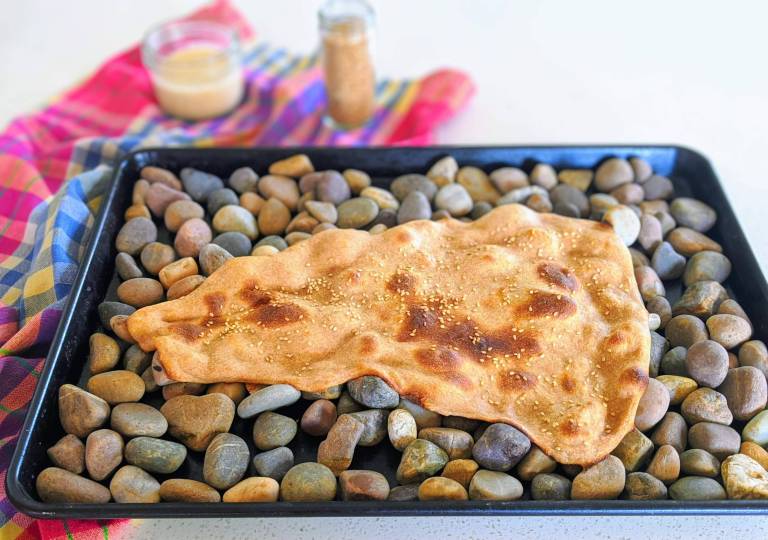A unique Persian flatbread baked on a layer of hot pebbles, giving it an uneven surface with many indentations. It has a higher ratio of whole wheat to all-purpose flour and is naturally leavened by a sourdough starter instead of yeast.
Naan Sangak - Persian flatbread
Bread is deeply integrated into Persian culture, and many types of flatbread appear on the Persian table to accompany breakfast, lunch and dinner. One of these is Sangak, which is truly unique in both its flavor and its baking techniques.
Ingredients
- 1/3 cup sourdough starter
- 1 cup whole wheat flour
- 1/3 cup all purpose flour
- 3/4 tsp sugar
- 1/2 cup water, room temperature, adjust volume as needed
- 1 tsp salt
- 2 tsp water, room temperature
- 1 tbsp oil
- 2 tsp sesame seeds
Directions
- This is an overnight process, so give yourself plenty of time for this recipe.
- In a medium sized mixing bowl, combine the sourdough starter, flours, sugar and water using a spatula or a fork. You will need to adjust the water according to how wet or dry your sourdough starter is: you should be aiming for a sticky dough that’s a little damper than typical bread dough. My sourdough starter was whole wheat, and on the wetter side, so I added a little less water.
- This is a no-knead dough, so all you have to do is mix the ingredients for about a minute until they come together. Easy!
- Cover and let sit at room temperature for 1 hour.
- Add the salt, additional water and oil, incorporating the added ingredients into the dough without actually kneading it. You might have to slightly stretch the dough and fold it onto itself several times.
- Cover and allow to rest at room temperature for 30 minutes.
- Once again, fold the dough a couple of times, cover and allow to rest for 30 minutes.
- One last time, fold the dough a couple of times, cover and allow to rest for 30 minutes.
- After the final 30 minutes of resting, fold the dough, cover, and place in the fridge overnight.
- When you are ready to bake the bread, remove the dough from the fridge. Cut the dough in half, keep covered in the same container and allow to sit at room temperature for 1 hour.
- Fill a baking sheet with pebbles (see notes below) and place on the lower rack of the oven. Preheat the oven to 500°F.
- You will need a small bowl of water, and a large flat plate that can be made wet.
- First wet your hands and then wet the surface of the plate. Make sure you don’t get the plate too wet, however.
- Place the first half of the dough on the wet plate and do your best to spread it out into a rough triangle about 15 inches long. Practice makes perfect but don’t fuss over this too much. Each bread will have its own unique shape!
- Carefully remove the HEAVY tray full of HOT pebbles from the oven and get ready to transfer the dough onto the tray.
- Slowly tip the plate so that the dough begins sliding off of the wet plate onto the pebbles. Gently pull the plate back in a smooth slow motion as the rest of the dough slides and lands on the pebbles. Help it along the way but make sure you don’t touch the hot pebbles! Once the dough is on the pebbles do not attempt to rearrange it, as it will already be stuck to the stones.
- Carefully place the tray back in the oven, and bake for 8-10 minutes depending on how the dough was spread out on the pebbles. The bread should be mottled brown as shown in the picture.
- Once baked, carefully remove the tray from the oven, and using tongs remove the bread carefully, including any pebbles that are stuck to the bread. No way around this, so don’t worry about it. Place on a cutting board until you can remove the pebbles without burning yourself.
- Repeat with the second half of the dough.
- This bread is best served fresh and hot out of the oven, of course. If you need to store the bread, keep it in an airtight container and reheat it in the oven or toaster oven before serving.
- I purchased my pebbles from a Home and Garden store, washed them thoroughly, and tested them in the oven to make sure that they were suitable for this purpose. To test them, I laid out the pebbles on a baking sheet, put another baking sheet on top and baked them at 520°F for 30 minutes to ensure that they can withstand the heat and not crack or shatter.

